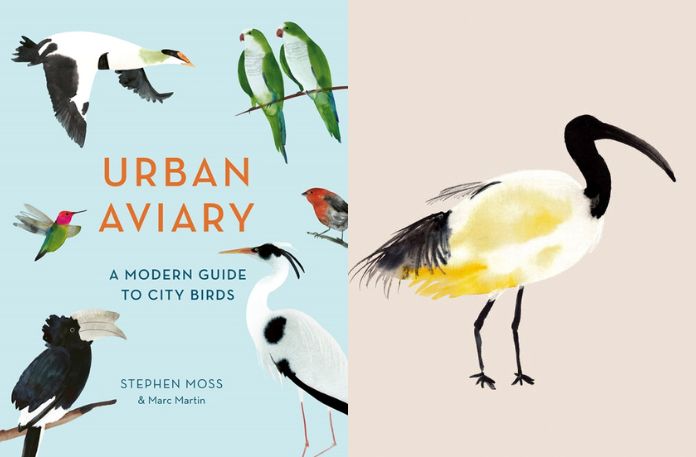Today’s Bird of the Day, the Australian white ibis, was recommended by City of Sydney Councillor, curator and author Jess Scully.
“I know they divide people,” she said, “but I’m on the side of the ibis.
“They’re not bin chickens, they’re elegant prehistoric time travellers who have somehow ended up in the heart of a 21st century city, and they’re finding a way to survive.
“How did we ever get so jaded that we’re oblivious to – even annoyed by – this stalking feathered dinosaur that somehow shares the streets with us. Resilience, tenacity, adaptability – the ibis has it all.”

The Australian white ibis is one of the Australian birds in Stephen Moss and Marc Martin’s Urban Aviary: A Guide to Modern City Birds.
“Birds evolve to live in specific habitats,” says Moss, “and some seem to adapt far better than others when it comes to living in cities. One such bird is the ‘bin chicken’ … a wetland species that has taken to urban life with ease.”
He says, “Ironically, though, the Australian white ibis is living in Australia’s cities because much of its wetland habitat in rural areas has been drained. So, while many city dwellers find its habits distasteful, the ibis is there because of our own wasteful and destructive habits.
“How different this is to ancient Egypt, where the sacred ibis was a symbol of Thoth, the god of writing and wisdom.”
In the introduction to the book Moss says to try looking at the phrase “urban jungle” literally, not metaphorically.
“Many towns and cities around the world have become a haven for a wide range of wild creatures that have to life alongside us in new, different and unexpected ways.”
Think about it a little longer, he says, and you will realise that a city can provide everything wildlife needs to survive.
The prospect that two thirds of ten billion people on the planet will soon be living in cities has “crucial implications for the future of both birds and ourselves”.
“If we welcome birds into our cities by providing food, water and places to nest, we will benefit too. All the evidence shows that regular contact with nature improves our physical, mental and emotional health.”
Thoth is also mentioned in A Guide to the Creatures in Your Neighbourhood.
“For many older Australians … [ibises] were seen as ’noble birds’, a symbol of knowledge, somewhat exotic. As a result, to one in the ‘wild’ was always very special, as if they had been taken directly off the wall of ancient Egypt.”
Ibises, it says, traditionally are carnivores, eating anything they can catch and swallow, especially those that make their lives in water, mud and among plants: frogs, snakes, fish, worms, moths and locusts.
“Their diet of human leftover foods is a recent addition in select urban situations, due to habitat loss.”
The book contains a section on ibises, including a who’s who of ibises, tips for ibis watching, and some “fascinating particulars”.
_______________
Follow @southsydneyherald on Instagram to see our birds of the day and learn about protecting urban biodiversity.





